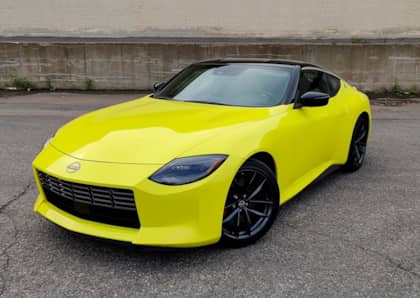Manual Transmission Nissan Z Proto Targets Auto-Only Toyota Supra With Retro Flair and Modern Twin Turbos
The Nissan Z has spent the past several years watching almost every other sports car on the market zoom by it in terms of performance, technology, and perhaps most telling, sales. With only a handful of examples finding new owners in 2019, the once-proud rear-wheel drive coupe has been on life support in world where the Chevrolet Corvette has morphed into a mid-engine monster and even four-cylinder hot hatches are turbocharging their way past the Nissan's performance envelope.
Despite being left to wither on the vine (it's been more than a decade since the current 370Z was, well, current) there's been a savior lurking in the background for nearly as long. Nissan was only able to break into the American market on the strength of the original (then Datsun) Z car back in the early 1970s, and high performance heritage runs deep at the brand. The brand's willingness to tap into that vein was displayed with the IDx concept car in 2013, which leaned heavily on the classic 510 coupe that dominated SCAA racing, but the Z had so far escaped the same kind of blast from the past.

That all changes with the Nissan Z Proto. Based on what we've been shown so far, here at last is a potential successor to the Nissan 370Z, and one that brings with it a certain retro flavor blended with a much heavier hammer under the hood. It's a high tech re-imagining of the old school sports coupe, but one that doesn't necessarily dip as deep into Nissan's past as it might at first seem.

Will it be enough to make the last letter of the alphabet relevant once more among high performance driving enthusiasts? And where, exactly, does a new Z fit into the modern sports car landscape?
'70s Meets '90s Meets Today
As the word 'proto' might indicate, the new Z concept draws some of its styling inspiration from the S30 generation of the car, which was sold from 1969 to 1978 in the United States.

This is most apparent from the front and the sides, where the long deck / short rear profile and curving roof line draw a clear line back to the classic. Its wide open, rectangular grille also matches the look of the first Z while simultaneously satisfying European pedestrian safety regulations.

That being said, the hindquarters of the Z Proto have much more in common with the early-90s ZX Turbo, particularly the brake light area and the flat drop to the bumper. The overriding styling also feels not far removed from this year's 370Z, especially the fat haunches, the shape of the hood, and the look of the door handles.

Parked side-by-side with the Proto, and it's clear that Nissan stylists are still very satisfied with the 2020 model year's pushed-out dimensions, and have used them to set the Z Proto apart from the smaller, and more svelte Subaru BRZ / Toyota 86 sports coupe.
Finally, Turbos
The latter two make an interesting comparator for Nissan's new sports car. The automaker has seen fit to slash prices on the 370Z to make it more competitive with its less-mighty, but more lightweight rivals, largely abandoning efforts to target pony car customers seeking the muscular embrace of the Ford Mustang and the Chevrolet Camaro. Nissan's long-running 3.7-liter V6 simply couldn't keep pace with the eight-cylinder arms race run by its domestic rivals.

That all changes with the Z Proto, which gives up its old naturally-aspirated mill for a twin-turbo six-cylinder that should produce at least 400 horsepower and similar levels of torque (based on the similar drivetrain found in sister brand Infiniti's Q60 sports coupe).

That's a substantial increase from the 2020 370Z, and well within sniping range of not just the Mustang and Camaro but also the newly revitalized Toyota Supra.

Another point in the Z Proto's favor—especially as compared to the Supra—is the focus on its six-speed manual gearbox. Although there will surely be a self-shifter available when the Proto makes it to market, the fact that it remains committed to the clutch pedal in an era where both Toyota's sports car and the Chevrolet Corvette had said good-bye to the same makes a unique statement.
Big Ripples, Small Pond
There's no avoiding the fact that only a tiny subset of new car buyers are interested in manual transmissions, and even fewer are looking to take home a sports coupe over an SUV. Still, as an image builder for a brand that has been relying on an also-aging GT-R to keep hopes alive for the high performance faithful, the idea of a shift-it-yourself Z with a legitimately powerful engine and a touch of throwback styling would seem to be more than enough to return the world's gaze to the once-proud badge.

It's also a formula that happens to fit well within the current performance car pecking order. Although there's been no word on price, moving the Z up market to distance itself from the BRZ/86 twins, and create a little space between it and the domestic crowd, too, would help the Z Proto settle somewhere comfortably in the Supra zone.

This isn't a car that's going to be threatening the Corvette's lap times like the last time the Z had a pair of turbochargers keeping things warm, but as long as it doesn't sticker for more than $50,000, and if its chassis can match the thrills promised by its expected horsepower numbers, there are buyers who want to stand apart from the crowd, and shift their own gears while doing it.
More From Driving Line
- Wonder what it costs to run a Datsun Z on the race track for a season? We tally up the costs of classic racing in this feature.
- Running late, but worth the wait? The Twin Turbo Next Gen Nissan Z Prototype is here.











